Friction welding is a superior method for welding Nitronic 50 components compared to conventional welding processes, e.g., MIG, TIG welding (tungsten inert gas), and plasma arc welding process. Friction welding never uses filler metals and requires minimum pre-weld joint preparation, displacing oils, oxidation, and other contaminations during welding. The metals reach a plasticized state before forging, creating a very narrow heat-affected zone (HAZ), protecting the molecular structure of the components while eliminating porosity and hot cracking. Friction welding creates a bond as strong as the base metals.
The image shows Nitronic 50 XM19 to 4130 stainless steel (larger diameter) welding.

Nitronic 50 Weld Specification
AFW works with customers to define a Weld Procedure Specification (WPS) that sets specific tolerance parameters for each part. Equipped with advanced high-precision controllers, our welding centers monitor all critical variables throughout the weld cycle, guaranteeing product conformance – RPMs (rotations per minute), PSI (weld pressure), and total stock length loss. Controlling forge ramp and deceleration is critical in maintaining consistent and standardized welds. The operator receives immediate notification if a weld parameter is out of range to take corrective action. We record data from each weld cycle for future parameter review and analysis.
This graph displays the friction weld cycle’s RPMs, PSI, and stock displacement.

Nitronic 50 Weld Bend Test
Friction welding bend tests are common to assess mechanical integrity and bonding strength. This testing method involves subjecting a friction-welded specimen to bending forces, which simulate real-world conditions and evaluate the weld’s resistance to deformation. A predetermined load is applied gradually to the sample during the test to achieve the desired bend angle. The test measures parameters such as the ultimate bending moment, the yield strength, and the ductility of the weld. By performing friction welding bend tests, engineers and researchers gain valuable insights into the quality and reliability of friction-welded joints, helping to ensure the structural integrity and performance of welded components in various applications.
Working With Nitronic 50
Nitronic 50, an exceptional high-strength austenitic stainless steel alloy, has emerged as a prime candidate for friction welding due to its unique properties. This alloy, also known as UNS S20910 or XM-19, is a member of the family of stainless steels. It stands out in the world of materials for its remarkable strength and corrosion resistance blend. Composed primarily of iron, chromium, nickel alloys, manganese, and nitrogen, Nitronic 50 derives its impressive properties from careful alloying.
Carbon diffusion is a critical concern in welding stainless steels, including Nitronic 50. Carbon atoms’ migration can lead to carbide formation along the grain boundaries, compromising corrosion resistance and mechanical properties. Friction welding, characterized by its short welding cycle and minimal heat input, significantly reduces the risk of carbon diffusion, preserving the integrity of the alloy. Intergranular corrosion is a common issue in stainless steel welding. However, friction welding’s minimal heat input and short cycle times mitigate the risk of intergranular corrosion in Nitronic 50 joints.
Nitronic 50 is renowned for its outstanding corrosion resistance, making it an ideal choice for applications in aggressive environments like marine, chemical, and oil and gas industries. In friction welding, the inherent properties of Nitronic 50 are retained in the weld metal, ensuring that the resulting joints maintain their corrosion resistance. Nitronic 50 also boasts excellent mechanical properties, including high tensile and yield strength. With its ability to create metallurgical solid bonds, the friction welding process ensures that the welded joints exhibit these desirable mechanical characteristics – making Nitronic 50-friction-welded components suitable for applications requiring structural integrity under heavy loads.
Friction welding also offers other notable benefits. It is a relatively quick process, with rapid cycle times and minimal post-weld cleaning or finishing required. The process can be automated, providing consistency and repeatability in production. Additionally, friction welding Nitronic 50 allows for joining dissimilar metals or alloys, expanding the possibilities for complex engineering designs and multi-material assemblies.
- Melting Point: 2,550 - 2,600°F | 1,400 - 1,430°C
- Thermal Conductivity: 15.6 W/m-K (watts per meter per kelvin)
Other Welding Combinations: Carbon Steel to Stainless Steel, Copper to Aluminum, Hastelloy Welding, Inconel to Inconel, Nitronic 50, Stainless Steel to Mild Steel, Stainless to Stainless
